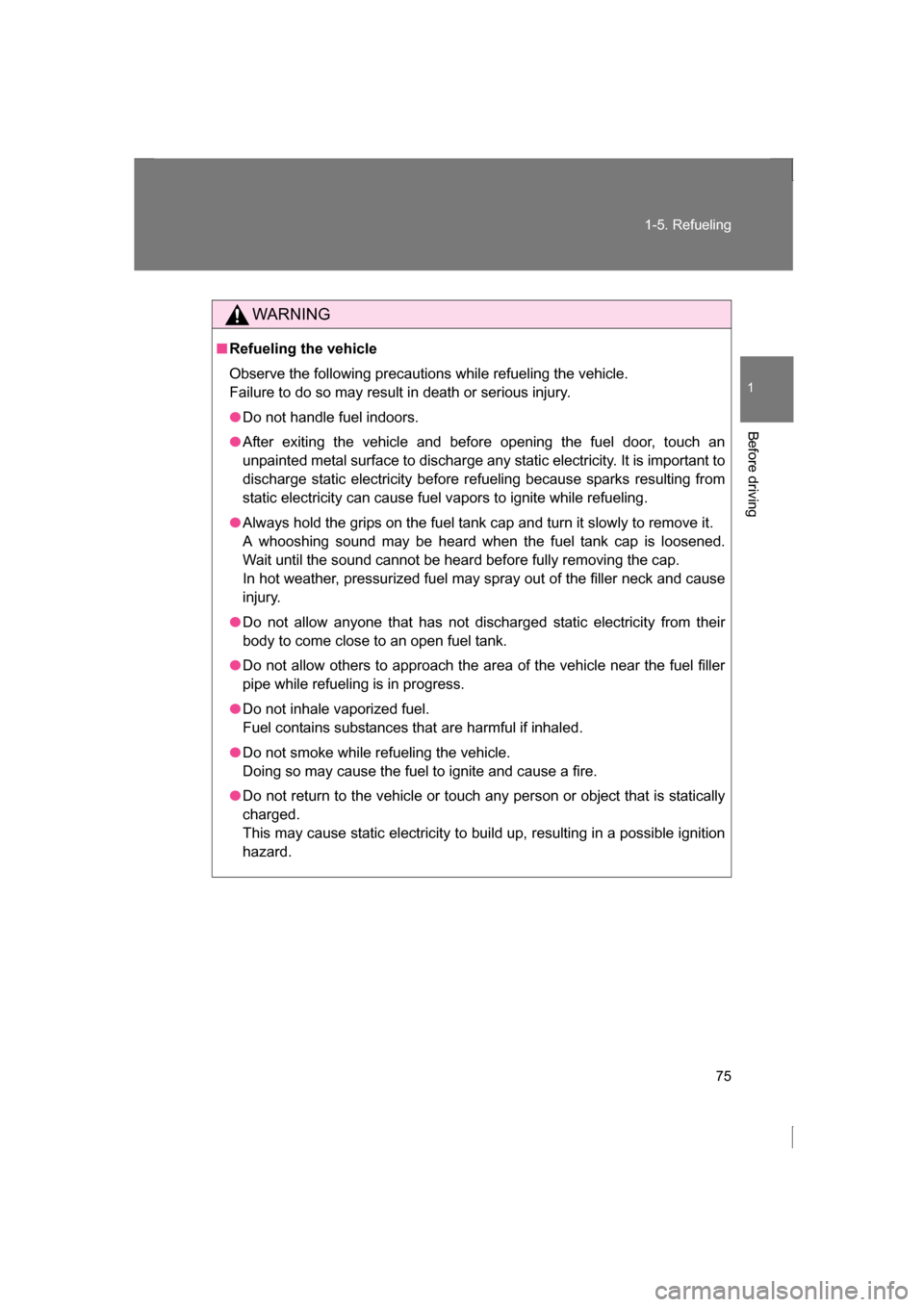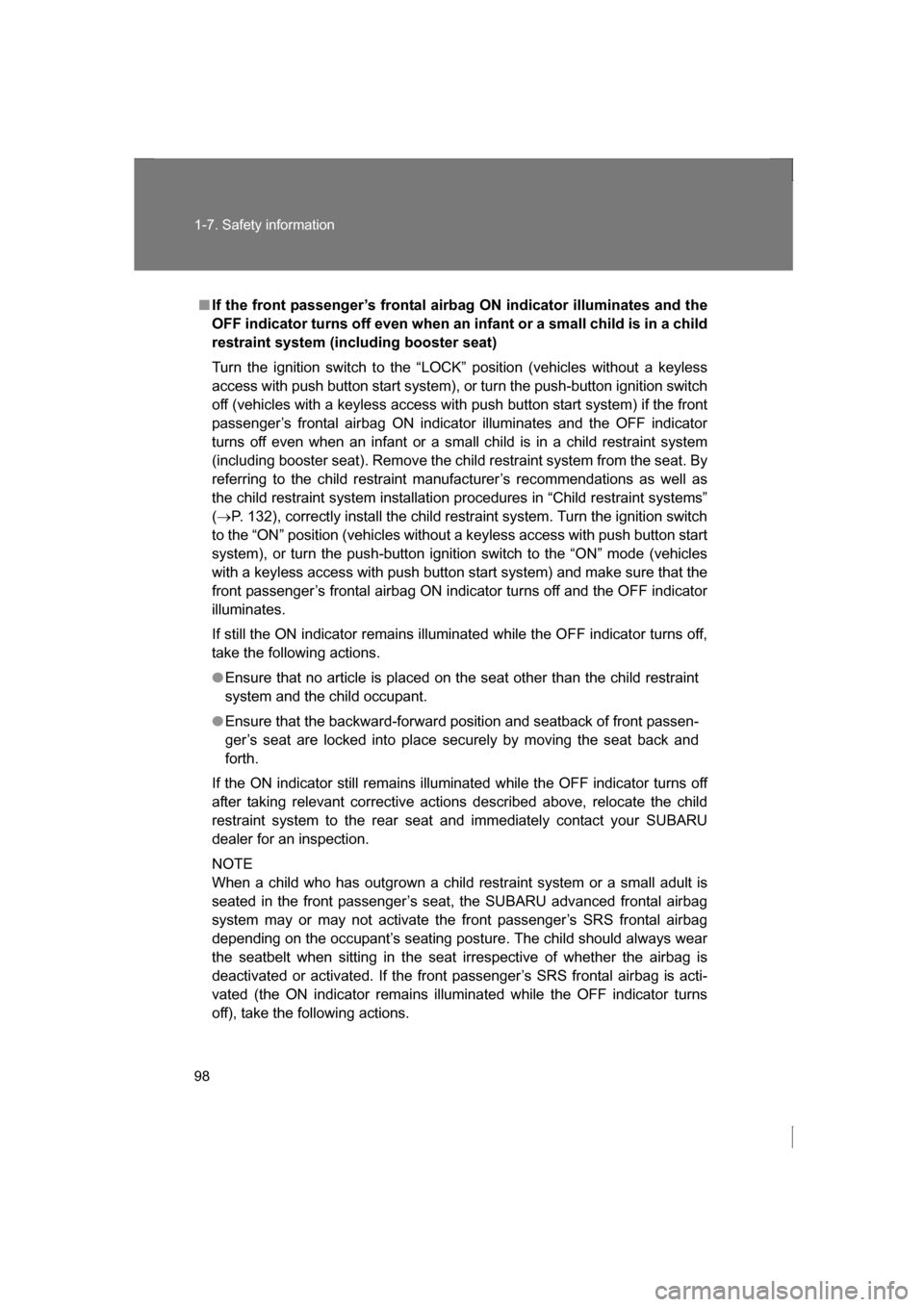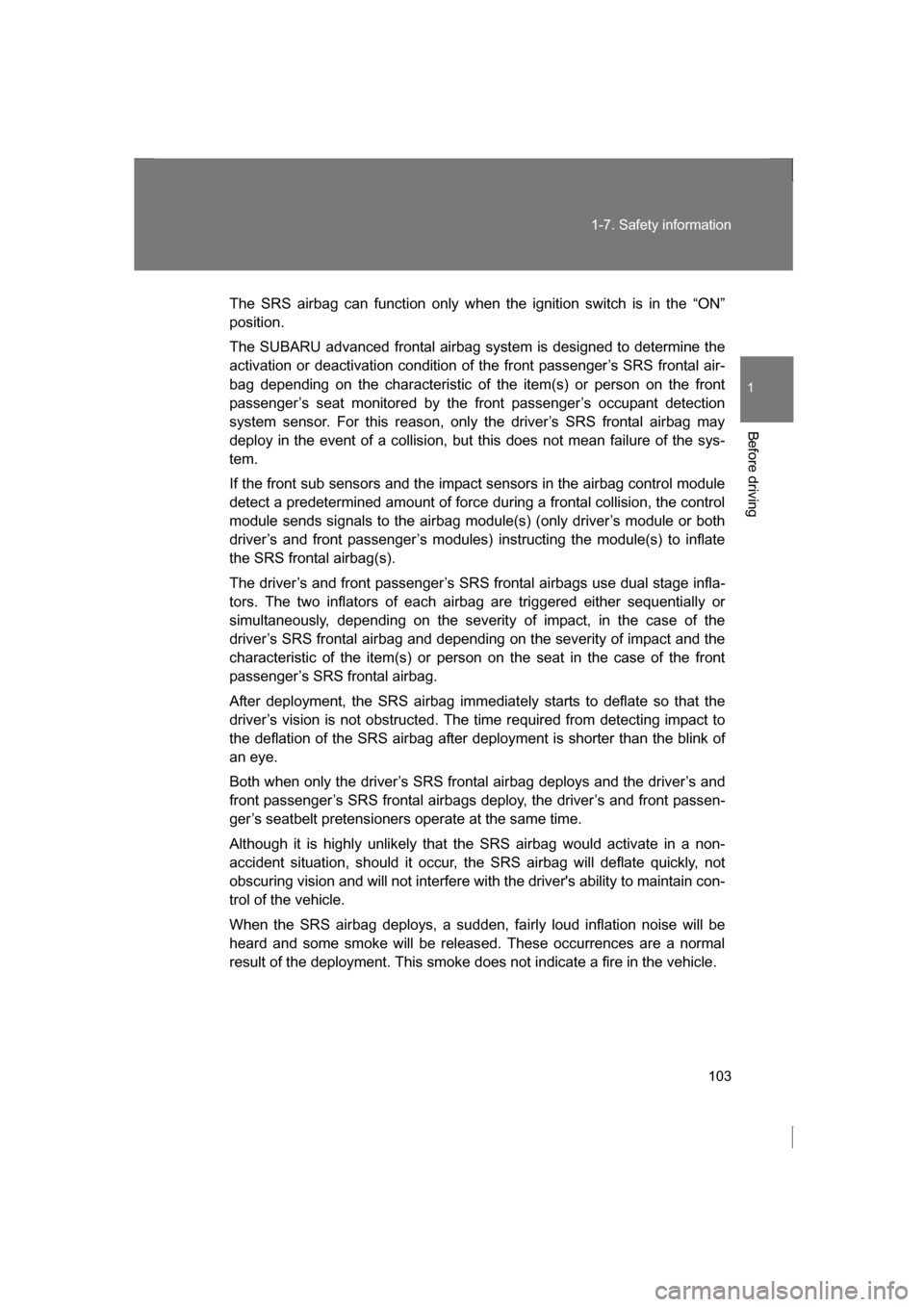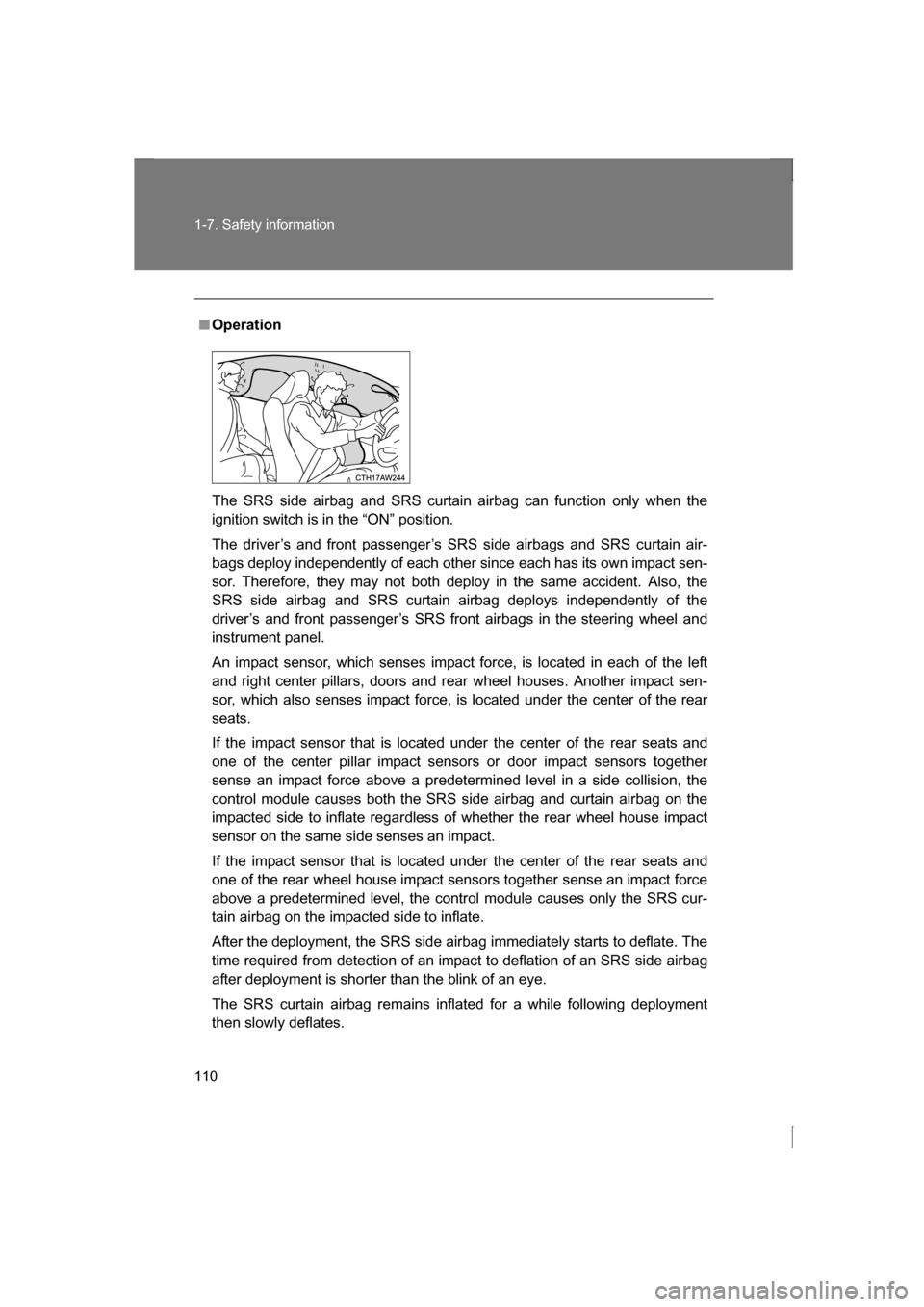2013 SUBARU BRZ ignition
[x] Cancel search: ignitionPage 73 of 484

73
1
Before driving
1-5. Refueling
Opening the fuel tank cap
Perform the following steps to open the fuel tank cap:
■Before refueling the vehicle ●Vehicles without a keyless access with push button start sys-
tem: Turn the engine switch off and ensure that all the doors
and windows are closed.
● Vehicles with a keyless access with push button start system:
Turn the push-button ignition switch off and ensure that all the
doors and windows are closed.
● Confirm the type of fuel. ( →P. 7 4 )
■Opening the fuel tank cap
Pull up the opener to open the
fuel filler lid.
Turn the fuel tank cap slowly
to open.
STEP 1
STEP 2
Page 75 of 484

75
1-5. Refueling
1
Before driving
WARNING
■Refueling the vehicle
Observe the following precautions while refueling the vehicle.
Failure to do so may result in death or serious injury.
●Do not handle fuel indoors.
●After exiting the vehicle and before opening the fuel door, touch an
unpainted metal surface to discharge any static electricity. It is important to
discharge static electricity before refueling because sparks resulting from
static electricity can cause fuel vapors to ignite while refueling.
●Always hold the grips on the fuel tank cap and turn it slowly to remove it.
A whooshing sound may be heard when the fuel tank cap is loosened.
Wait until the sound cannot be heard before fully removing the cap.
In hot weather, pressurized fuel may spray out of the filler neck and cause
injury.
●Do not allow anyone that has not discharged static electricity from their
body to come close to an open fuel tank.
●Do not allow others to approach the area of the vehicle near the fuel filler
pipe while refueling is in progress.
●Do not inhale vaporized fuel.
Fuel contains substances that are harmful if inhaled.
●Do not smoke while refueling the vehicle.
Doing so may cause the fuel to ignite and cause a fire.
●Do not return to the vehicle or touch any person or object that is statically
charged.
This may cause static electricity to build up, resulting in a possible ignition
hazard.
Page 78 of 484

78
1-6. Security system
■When the vehicle cannot be started with the registered key (vehicles
without a keyless access with push button start system)
Remove the key and try again.
■System maintenance
The vehicle has a maintenance-free type engine immobilizer system.
■Conditions that may cause the system to malfunction
●If the key is in contact with a metallic object
●If the key is in close proximity to or touching a key to the security system
(key with a built-in transponder chip) of another vehicle Vehicles with a keyless
access with push button
start system
The indicator light flashes after
the push-button ignition switch
has been turned off to indicate
that the system is operating.
The indicator light stops flash-
ing after the push-button igni-
tion switch has been turned to
“ACC” or “ON” mode to indi-
cate that the system has been
canceled.
Page 82 of 484

82
1-6. Security system
Activating/deactivating the alarm systemCheck that both side doors and the trunk lid are closed.
Turn the push-button ignition switch to “ON” mode. Open the driver’s door while
pressing and holding on
the power door lock switch and
continue to press for
approximately 10 seconds after
the driver’s door has opened.
The alarm system changes
between activated and deacti-
vated as follows.
■Deactivating or stopping the alarm
Perform one of the following to deactivate or stop the alarm: ● Unlock the doors using the “keyless access” entry function.
● Unlock the doors using the remote keyless entry system.
● Turn the push-button ignition switch to “ACC” or “ON” mode,
or start the engine. (The alarm will be deactivated or stopped
after a few seconds.)
STEP 1
STEP 2
STEP 3
Alarm statusHornMulti-information dis-
play
Deactivated Sounds twice AL oF
Activated Sounds once AL on
Page 98 of 484

98
1-7. Safety information
■If the front passenger’s frontal airbag ON indicator illuminates and the
OFF indicator turns off even when an infant or a small child is in a child
restraint system (including booster seat)
Turn the ignition switch to the “LOCK” position (vehicles without a keyless
access with push button start system), or turn the push-button ignition switch
off (vehicles with a keyless access with push button start system) if the front
passenger’s frontal airbag ON indicator illuminates and the OFF indicator
turns off even when an infant or a small child is in a child restraint system
(including booster seat). Remove the child restraint system from the seat. By
referring to the child restraint manufacturer’s recommendations as well as
the child restraint system installation procedures in “Child restraint systems”( → P. 132), correctly install the child restraint system. Turn the ignition switch
to the “ON” position (vehicles without a keyless access with push button start
system), or turn the push-button ignition switch to the “ON” mode (vehicles
with a keyless access with push button start system) and make sure that the
front passenger’s frontal airbag ON indicator turns off and the OFF indicator
illuminates.
If still the ON indicator remains illuminated while the OFF indicator turns off,
take the following actions.
●Ensure that no article is placed on the seat other than the child restraint
system and the child occupant.
●Ensure that the backward-forward position and seatback of front passen-
ger’s seat are locked into place securely by moving the seat back andforth.
If the ON indicator still remains illuminated while the OFF indicator turns off
after taking relevant corrective actions described above, relocate the child
restraint system to the rear seat and immediately contact your SUBARU
dealer for an inspection.
NOTE
When a child who has outgrown a child restraint system or a small adult is
seated in the front passenger’s seat, the SUBARU advanced frontal airbag
system may or may not activate the front passenger’s SRS frontal airbag
depending on the occupant’s seating posture. The child should always wear
the seatbelt when sitting in the seat irrespective of whether the airbag is
deactivated or activated. If the front passenger’s SRS frontal airbag is acti-
vated (the ON indicator remains illuminated while the OFF indicator turns
off), take the following actions.
Page 100 of 484

100
1-7. Safety information
■If the passenger’s frontal airbag OFF indicator illuminates and the ON
indicator turns off even when the front passenger’s seat is occupied by
an adult
This can be caused by the adult incorrectly sitting in the front passenger’s
seat. Turn the ignition switch to the “LOCK” position (vehicles without a key-
less access with push button start system), or turn the push-button ignition
switch off (vehicles with a keyless access with push button start system).
Ask the front passenger to set the seatback to the upright position, sit up
straight in the center of the seat cushion, correctly fasten the seatbelt, posi-
tion his/her legs out forward, and adjust the seat to the rearmost position.
Turn the ignition switch to the “ON” position (vehicles without a keyless
access with push button start system), or turn the push-button ignition switch
to the “ON” mode (vehicles with a keyless access with push button start sys-
tem). If the OFF indicator remains illuminated while the ON indicator remains
off, take the following actions.
●Vehicles without a keyless access with push button start system:
Turn the ignition switch to the “LOCK” position.
Vehicles with a keyless access with push button start system:
Turn the push-button ignition switch off.
●Make sure that the front passenger does not use a blanket, seat cushion,
seat cover, seat heater or massager, etc.
●If wearing excessive layers of clothing, the front passenger should
remove any unnecessary items before sitting in the front passenger’s
seat, or should sit in a rear seat.
●Next, turn the ignition switch to the “ON” position and wait 6 seconds to
allow the system to complete self-checking. Following the system check,
both indicators turn off for 2 seconds. Now, the ON indicator should illu-
minate while the OFF indicator remains off.
If the OFF indicator still remains illuminated while the ON indicator remains
off, ask the occupant to move to the rear seat and immediately contact your
SUBARU dealer for an inspection.
Page 103 of 484

103
1-7. Safety information
1
Before driving
The SRS airbag can function only when the ignition switch is in the “ON”
position.
The SUBARU advanced frontal airbag system is designed to determine the
activation or deactivation condition of the front passenger’s SRS frontal air-
bag depending on the characteristic of the item(s) or person on the front
passenger’s seat monitored by the front passenger’s occupant detection
system sensor. For this reason, only the driver’s SRS frontal airbag may
deploy in the event of a collision, but this does not mean failure of the sys-tem.
If the front sub sensors and the impact sensors in the airbag control module
detect a predetermined amount of force during a frontal collision, the control
module sends signals to the airbag module(s) (only driver’s module or both
driver’s and front passenger’s modules) instructing the module(s) to inflate
the SRS frontal airbag(s).
The driver’s and front passenger’s SRS frontal airbags use dual stage infla-
tors. The two inflators of each air bag are triggered either sequentially or
simultaneously, depending on the severity of impact, in the case of the
driver’s SRS frontal airbag and depending on the severity of impact and the
characteristic of the item(s) or person on the seat in the case of the front
passenger’s SRS frontal airbag.
After deployment, the SRS airbag immediat ely starts to deflate so that the
driver’s vision is not obstructed. The time required from detecting impact to
the deflation of the SRS airbag after deployment is shorter than the blink of
an eye.
Both when only the driver’s SRS frontal airbag deploys and the driver’s and
front passenger’s SRS frontal airbags deploy, the driver’s and front passen-
ger’s seatbelt pretensioners operate at the same time.
Although it is highly unlikely that the SRS airbag would activate in a non-
accident situation, should it occur, the SRS airbag will deflate quickly, not
obscuring vision and will not interfere with the driver's ability to maintain con-
trol of the vehicle.
When the SRS airbag deploys, a sudden, fa irly loud inflation noise will be
heard and some smoke will be released. These occurrences are a normal
result of the deployment. This smoke does not indicate a fire in the vehicle.
Page 110 of 484

110
1-7. Safety information
■Operation
The SRS side airbag and SRS curtain airbag can function only when the
ignition switch is in the “ON” position.
The driver’s and front passenger’s SRS side airbags and SRS curtain air-
bags deploy independently of each other since each has its own impact sen-
sor. Therefore, they may not both deploy in the same accident. Also, the
SRS side airbag and SRS curtain airbag deploys independently of the
driver’s and front passenger’s SRS front airbags in the steering wheel and
instrument panel.
An impact sensor, which senses impact force, is located in each of the left
and right center pillars, doors and rear wheel houses. Another impact sen-
sor, which also senses impact force, is located under the center of the rear
seats.
If the impact sensor that is located under the center of the rear seats and
one of the center pillar impact sensors or door impact sensors together
sense an impact force above a predetermined level in a side collision, the
control module causes both the SRS side airbag and curtain airbag on the
impacted side to inflate regardless of whether the rear wheel house impact
sensor on the same side senses an impact.
If the impact sensor that is located under the center of the rear seats and
one of the rear wheel house impact sensors together sense an impact force
above a predetermined level, the control module causes only the SRS cur-
tain airbag on the impacted side to inflate.
After the deployment, the SRS side airbag immediately starts to deflate. The
time required from detection of an impact to deflation of an SRS side airbag
after deployment is shorter than the blink of an eye.
The SRS curtain airbag remains inflated for a while following deployment
then slowly deflates.